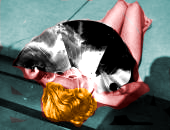Facial Resonance and Twang Part 2
 In Part 1of Facial Resonance and Twang, we enhanced resonance awareness by focusing on vibrations in the nose. In this step, we'll focus our awareness in our mouths, and feel the sensations in the bones of the face and skull.
In Part 1of Facial Resonance and Twang, we enhanced resonance awareness by focusing on vibrations in the nose. In this step, we'll focus our awareness in our mouths, and feel the sensations in the bones of the face and skull.
To begin, take the vibrant, buzzy quality of the /m/ consonant, and open it up into an "uh" vowel (IPA [ʌ]). Do this repeatedly, lingering on an /m/ to begin with, and then popping from /m/ into uh with a series of "muh-muh-muh-muh-muh"s (5 in a row works wonderfully). [mmmmmmmmʌ-mʌ-mʌ-mʌ-mʌː] Work your way up by semitones, feeling how the buzziness from your nose translates into a different kind of buzziness that goes through your mouth.
At this stage, it's very possible that you're making a nasal vowel, that is the sound of the "uh" [ʌ] vowel is going through your nose and mouth. Though ideally we want the sound to travel more through your mouth than your nose, for this exercise it isn't that important. If you can think of the sound popping out your mouth, rather than honking out your nose, you're likely to be able to get the sound/feeling you want.
Warming Your Hands, Warming Your Face
Now, I'd like you to cup your hands in front of your face, palms facing your face as if your have covered your face with your hands and then pulled your hands away from your face about 4 to 6 inches. Your hands are now a reflector for the vibrations that will come from your voice through your face. Starting at a comfortable mid-range pitch, sustain an /m/ for a 2 or 3 seconds, and then open up to "uh" [ʌ] for 5 seconds or so. Again, work your way up in pitch through your voice range, focusing on the sensation of vibrations in your face and the feeling of buzziness that you're catching in your hands. Move your hands around slowly, as if you were reflecting the buzz onto the surface of your face; bask in the glow of your voice. See if you can lift your soft palate gently as you open onto "uh" [ʌ] so that you enhance the mouth quality of the sound (rather than it being stuck in your nose).
Finally, focus on breath in your belly and release little touches of sound on "huh" [hʌ], letting the sound me more like a sigh than a sustained pitch. Be sure to focus the sound in the middle of your voice, so it vibrates your face and neck, rather than your chest. Think of making little question inflections on your "huh" and then answer your questions with a statement of face "huh". Keep trying to find a sense of ease while trying to maintain the sensation of vibration that you've discovered up to this point.
Next Step: Articulation of L and N on the Gum Ridge